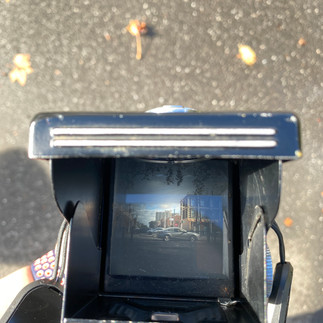It took me hardly any time to venture into the world of medium format photography. Brimming with excitement, I acquired my inaugural medium format film camera—the Yashicaflex Model C, a twin-lens reflex (TLR) camera.
A bit of trivia for the uninitiated: A TLR camera features two objective lenses with identical focal lengths. One serves as the photographic or "taking" lens, whilst the other is designated for the viewfinder system, typically viewed from above at waist level. This type of camera has its roots in the late 19th century.
The camera set me back around AUD$250, sourced from eBay in Japan. I was utterly captivated by the craftsmanship; it's worth noting that its initial manufacture date was 1955. Shooting with a target square viewfinder elevates the experience to an entirely different stratum.
While the optical performance may not be superior, the experience of shooting with 120 film is on an entirely different plane compared to 35mm. I often liken film to a canvas; the larger the canvas, the more detail one can imbue it with. Allow me to elucidate with some straightforward mathematics:
The discrepancy in film area between 120 film and 35mm is rather considerable. A 35mm film frame measures approximately 24 x 36 mm, providing an area of roughly 864 square mm per frame. Conversely, 120 film is more versatile, accommodating a variety of frame formats, such as 6 x 4.5 cm, 6 x 6 cm, or even 6 x 9 cm. Given that the Model C utilises a 6 x 6 cm format, each frame would span an area of 3600 square mm.
To make a comparison:
- In the case of 120 film using a 6 x 6 cm format, the frame area would be about 3600 square mm.
- With 35mm film, the frame area hovers around 864 square mm.
Thus, from an area perspective, a 6 x 6 cm frame on 120 film is approximately 4.17 times larger than its 35mm counterpart.
Though these calculations are approximate, they should suffice in illustrating the vast potential for detail and quality inherent in 120 film.
Whilst the photos may not be extraordinary, they represent my inaugural foray into medium format photography.
It wasn't long before I acquired another medium format camera: the Mamiya M645J, which employs a 6x4.5 format. This model allows for 15 shots per roll of 120 film, compared to the 12 shots one gets with a 6x6 format like the Yashica Model C. I purchased it locally during lockdown for approximately AUD$600, bundled with a Mamiya Sekor C 80mm f2.8 lens. The Mamiya 645 series is a marvel of modularity, granting photographers the flexibility to customise nearly every aspect of the camera—ranging from film cartridges and focusing screens to viewfinders and even the film-advancing knob. In contrast to the waist-level viewfinder in the Model C, the M645J came equipped with an eye-level viewfinder, offering a different photographic experience altogether.

The Mamiya M645J I acquired is one of the more modest models in the series, lacking certain features like a mirror lock-up button. It comes with a single shutter button and offers a maximum shutter speed of 1/500s. Yet, for my needs as a casual photographer, it's more than adequate. Despite its somewhat bulky form, it's become a cherished piece of kit that I find myself taking with me whenever I venture out.
I took a plethora of photographs with this new addition to my kit, experimenting with various film stocks and capturing candid moments. Shooting portraits for friends became both my joy and passion during the challenging times of the COVID-19 pandemic. Life was difficult for everyone, but photography offered a respite, a way to make sense of the world amid the chaos.
In my next post, I'll delve into how I began capturing portraits. Until then, keep your lenses focused and your shutters clicking. Happy shooting!






















































Kommentarer